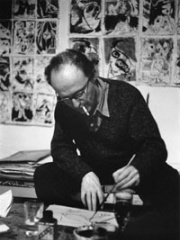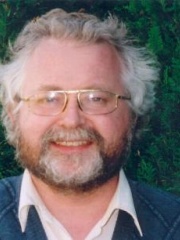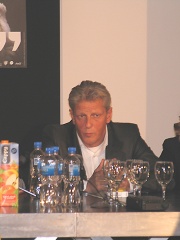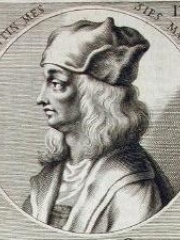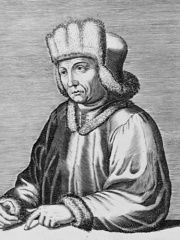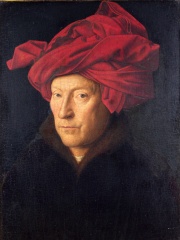
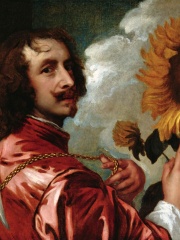
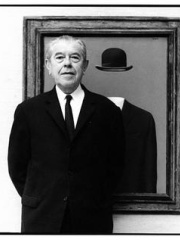
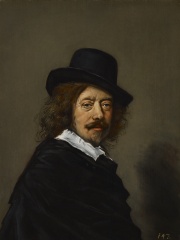
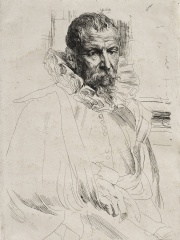
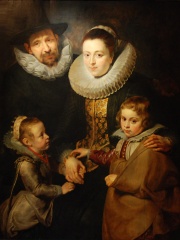
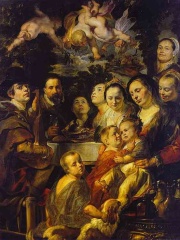
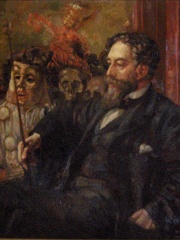
The Most Famous
PAINTERS from Belgium
This page contains a list of the greatest Belgian Painters. The pantheon dataset contains 2,023 Painters, 109 of which were born in Belgium. This makes Belgium the birth place of the 7th most number of Painters behind Netherlands, and United Kingdom.
Top 10
The following people are considered by Pantheon to be the top 10 most legendary Belgian Painters of all time. This list of famous Belgian Painters is sorted by HPI (Historical Popularity Index), a metric that aggregates information on a biography's online popularity. Visit the rankings page to view the entire list of Belgian Painters.

1. Jan van Eyck (1395 - 1441)
With an HPI of 82.52, Jan van Eyck is the most famous Belgian Painter. His biography has been translated into 79 different languages on wikipedia.
Jan van Eyck ( van EYEK; Dutch: [ˈjɑɱ vɑn ˈɛik]; c. before 1390 – 9 July 1441) was a Flemish painter active in Bruges who was one of the early innovators of what became known as Early Netherlandish painting, and one of the supreme figures of the Early Northern Renaissance. Such was his legacy, that he has been called “the inventor of oil-painting” by Vasari, Ernst Gombrich, and others, although this claim is now considered an oversimplification. Surviving records date his birth at around 1380 or 1390, in Maaseik (then Maaseyck, hence his name), Limburg, which is located in present-day Belgium. He took employment in The Hague around 1422, when he was already a master painter with workshop assistants, and was employed as painter and valet de chambre to John III the Pitiless, ruler of the counties of Holland and Hainaut. Some time after John's death in 1425, he was appointed as court painter to Philip the Good, Duke of Burgundy, and worked in Lille before moving to Bruges in 1429, where he lived until his death. He was highly regarded by Philip, and was dispatched on several diplomatic visits abroad, including one to Lisbon in 1428 to discuss the possibility of a marriage contract between the duke and Isabella of Portugal. About 20 surviving paintings are confidently attributed to him, as well as the Ghent Altarpiece and the illuminated miniatures of the Turin-Milan Hours, all dated between 1432 and 1439. Ten are dated and signed with a variation of his motto ALS ICH KAN (As I (Eyck) can), a pun on his name, which he typically painted in Greek characters. Van Eyck painted both secular and religious subjects. His works include altarpieces, painted panels—diptychs (dismantled), triptychs, and polyptychs—and commissioned portraits. He was well paid by Philip, who wanted the painter to have the financial security and artistic freedom to paint "whenever he pleased." Van Eyck's early work shows influence from the International Gothic style, which he soon eclipsed, in part through a greater emphasis on naturalism and realism. He achieved a new level of virtuosity through his developments in the use of oil paint. His style and techniques profoundly altered the development of the Early Netherlandish school.

2. Anthony van Dyck (1599 - 1641)
With an HPI of 80.23, Anthony van Dyck is the 2nd most famous Belgian Painter. His biography has been translated into 78 different languages.
Sir Anthony van Dyck (; Dutch: Antoon van Dyck [ˈɑntoːɱ‿vɑn ˈdɛik]; 22 March 1599 – 9 December 1641) was a Flemish Baroque artist who became the leading court painter in England after success in the Spanish Netherlands and Italy. The seventh child of Frans van Dyck, a wealthy silk merchant in Antwerp, Anthony painted from an early age. He was successful as an independent painter in his late teens and became a master in the Antwerp Guild on 18 October 1617. By this time, he was working in the studio of the leading northern painter of the day, Peter Paul Rubens, who became a major influence on his work. Van Dyck worked in London for some months in 1621, then returned to Flanders for a brief time, before travelling to Italy, where he stayed until 1627, mostly in Genoa. In the late 1620s he completed his greatly admired Iconography series of portrait etchings of mainly other artists and other famous contemporaries. He spent five years in Flanders after his return from Italy, and from 1630 was court painter for the Archduchess Isabella, Habsburg Governor of Flanders. At the request of Charles I of England he returned in 1632 to London as the main court painter. With the exception of Holbein, van Dyck and his contemporary Diego Velázquez were the first painters of pre-eminent talent to work mainly as court portraitists, revolutionising the genre. Van Dyck is best known for his portraits of the aristocracy, most notably Charles I, and his family and associates. He was the dominant influence on English portrait-painting for over 150 years. He also painted mythological, allegorical and biblical subjects, including altarpieces, displayed outstanding facility as a draughtsman, and was an important innovator in watercolour and etching. His influence extends into the modern period. The Van Dyke beard is named after him. During his lifetime, Charles I granted him a knighthood, and he was buried in St Paul's Cathedral, an indication of his standing at the time of his death.

3. René Magritte (1898 - 1967)
With an HPI of 80.07, René Magritte is the 3rd most famous Belgian Painter. His biography has been translated into 77 different languages.
René François Ghislain Magritte (French: [ʁəne fʁɑ̃swa ɡilɛ̃ maɡʁit]; 21 November 1898 – 15 August 1967) was a Belgian surrealist artist known for his depictions of familiar objects in unfamiliar, unexpected contexts, which often provoked questions about the nature and boundaries of reality and representation. His imagery has influenced pop art, minimalist art, and conceptual art.

4. Frans Hals (1582 - 1666)
With an HPI of 78.63, Frans Hals is the 4th most famous Belgian Painter. His biography has been translated into 65 different languages.
Frans Hals the Elder (UK: , US: ; Dutch: [frɑns ˈɦɑls]; c. 1582 – 26 August 1666) was a Dutch Golden Age painter. He lived and worked in Haarlem, a city in which the local authority of the day frowned on religious painting in places of worship but citizens liked to decorate their homes with works of art. Hals was highly sought after by wealthy burgher commissioners of individual, married-couple, family, and institutional-group portraits. He also painted tronies for the general market. There were two quite distinct schools of portraiture in 17th-century Haarlem: the neat (represented, for example, by Verspronck); and a looser, more painterly style at which Frans Hals excelled. Some of Hals's portrait work is characterised by a subdued palette, reflecting the politely serious tones of his fashionable clients' wardrobe. In contrast, the personalities he paints are full of life, typically with a friendly glint in the eye or the glimmer of a smile on the lips. Hals was born at Antwerp in the southern Spanish Netherlands, but because of the chaos wrought there by the Spanish at that time, his family moved to Haarlem when he was little. Many of his Haarlem clients were also émigrés from the South.
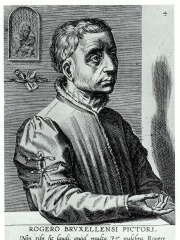
5. Rogier van der Weyden (1390 - 1464)
With an HPI of 78.33, Rogier van der Weyden is the 5th most famous Belgian Painter. His biography has been translated into 60 different languages.
Rogier van der Weyden (Dutch: [roːˈɣiːr vɑn dər ˈʋɛidə(n)]; 1399 or 1400 – 18 June 1464), initially known as Roger de la Pasture (French: [ʁɔʒe d(ə) la pastyʁ]), was an early Netherlandish painter whose surviving works consist mainly of religious triptychs, altarpieces, and commissioned single and diptych portraits. He was highly successful in his lifetime; his paintings were exported to Italy and Spain, and he received commissions from, amongst others, Philip the Good, Netherlandish nobility, and foreign aristocrats. By the latter half of the 15th century, he had eclipsed Jan van Eyck in popularity. However his fame lasted only until the 17th century, and largely due to changing taste, he was almost totally forgotten by the mid-18th century. His reputation was slowly rebuilt during the 200 years that followed; today he is known, with Robert Campin and van Eyck, as the third (by birth date) of the three great Early Netherlandish artists (Vlaamse Primitieven or "Flemish Primitives"), and widely as the most influential Northern painter of the 15th century. Very few details of van der Weyden's life are known. The few facts we know come from fragmentary civic records. Yet the attribution of paintings now associated to him is widely accepted, partly on the basis of circumstantial evidence, but primarily on the stylistic evidence of a number of paintings by an innovative master. Van der Weyden worked from life models, and details were closely observed. Yet he often idealised certain elements of his models' facial features, who were typically statuesque, especially in his triptychs. All of his forms are rendered with rich, warm colourisation and a sympathetic expression, while he is known for his expressive pathos and naturalism. His portraits tend to be half length and half profile, and he is as sympathetic here as in his religious triptychs. Van der Weyden used an unusually broad range of colours and varied tones; in his finest work the same tone is not repeated in any other area of the canvas, so even the whites are varied.

6. Pieter Brueghel the Younger (1564 - 1636)
With an HPI of 75.41, Pieter Brueghel the Younger is the 6th most famous Belgian Painter. His biography has been translated into 45 different languages.
Pieter Brueghel (also Bruegel or Breughel) the Younger ( BROY-gəl, also US: BROO-gəl; Dutch: [ˈpitər ˈbrøːɣəl] ; between 23 May and 10 October 1564 – between March and May 1638) was a Flemish painter known for numerous copies after his father Pieter Bruegel the Elder's work, as well as original compositions and Bruegelian pastiches. The large output of his studio (some 1,400 pictures exist with plausible links to Brueghel and his shop), which produced for the local and export market, contributed to the international spread of his father's imagery. Traditionally Pieter Brueghel the Younger was nicknamed "de helse Brueghel" or "Hellish Brueghel" on the belief that he was the author of several paintings with fantastic depictions of fire and grotesque imagery. These paintings have now been attributed to his brother Jan Brueghel the Elder.

7. Jan Brueghel the Elder (1568 - 1625)
With an HPI of 74.63, Jan Brueghel the Elder is the 7th most famous Belgian Painter. His biography has been translated into 44 different languages.
Jan Brueghel (also Bruegel or Breughel) the Elder ( BROY-gəl, US also BROO-gəl; Dutch: [ˈjɑm ˈbrøːɣəl] ; 1568 – 13 January 1625) was a Flemish painter and draughtsman. He was the younger son of the eminent Flemish Renaissance painter Pieter Bruegel the Elder. A close friend and frequent collaborator with Peter Paul Rubens, the two artists were the leading Flemish painters in the Flemish Baroque painting of the first three decades of the 17th century. Brueghel worked in many genres including history paintings, flower still lifes, allegorical and mythological scenes, landscapes and seascapes, hunting pieces, village scenes, battle scenes and scenes of hellfire and the underworld. He was an important innovator who invented new types of paintings such as flower garland paintings, paradise landscapes, and gallery paintings in the first quarter of the 17th century. However, he generally avoided painting large figures, as in portraits, though he often collaborated with other painters who did these, while he did the landscape backgrounds, and sometimes the clothes. He further created genre paintings that were imitations, pastiches and reworkings of his father's works, in particular his father's genre scenes and landscapes with peasants. Brueghel represented the type of the pictor doctus, the erudite painter whose works are informed by the religious motifs and aspirations of the Catholic Counter-Reformation as well as the scientific revolution with its interest in accurate description and classification. He was court painter of the Archduke and Duchess Albrecht and Isabella, sovereigns of the Spanish Netherlands. The artist was nicknamed "Velvet" Brueghel, "Flower" Brueghel, and "Paradise" Brueghel. The first is believed to have been given him because of his mastery in the rendering of fabrics. The second nickname is a reference to his fame as a painter of (although not a specialist in) flower pieces and the last one to his invention of the genre of the paradise landscape. His brother Pieter Brueghel the Younger was traditionally nicknamed "de helse Brueghel" or "Hell Brueghel" because it was believed he was the author of a number of paintings with fantastic depictions of fire and grotesque imagery. These paintings have now been reattributed to Jan Brueghel the Elder.

8. Jacob Jordaens (1593 - 1678)
With an HPI of 73.06, Jacob Jordaens is the 8th most famous Belgian Painter. His biography has been translated into 40 different languages.
Jacques (Jacob) Jordaens (19 May 1593 – 18 October 1678) was a Flemish painter, draughtsman and a designer of tapestries and prints. He was a prolific artist who created biblical, mythological, and allegorical compositions, genre scenes, landscapes, illustrations of Flemish sayings and portraits. After the death of Rubens and Anthony van Dyck, he became the leading Flemish Baroque painter of his time. Unlike those illustrious contemporaries he never travelled abroad to study the Antique and Italian painting and, except for a few short trips to locations elsewhere in the Low Countries, he resided in Antwerp his entire life. He also remained largely indifferent to Rubens and van Dyck's intellectual and courtly aspirations. This attitude was expressed in his art through a lack of idealistic treatment which contrasted with that of these contemporaries. His principal patrons were the wealthy bourgeoisie and local churches. Only late in his career did he receive royal commissions, including from King Charles I of England, Queen Christina of Sweden and the stadtholder class of the Dutch Republic. As well as being a successful painter, he was a prominent designer of tapestries and prints. While he is today mostly identified with his large-scale genre scenes such as The King Drinks (also called the Feast of the Bean King) and As the Old Sing, So Pipe the Young, his contemporary reputation was based as much on his numerous mythological, allegorical and biblical scenes. Often regarded as a pupil and epigone of Rubens, he was never recorded as a member of Rubens' workshop. He regularly worked as an independent collaborator of Rubens. The principal influence of Rubens on his work is the use of the chiaroscuro technique which Rubens himself had mastered through his study of Caravaggio's paintings during his stay in Italy. His main artistic influences, besides Rubens, were northern Italian painters such as Jacopo Bassano, Paolo Veronese, and Caravaggio.

9. James Ensor (1860 - 1949)
With an HPI of 72.94, James Ensor is the 9th most famous Belgian Painter. His biography has been translated into 43 different languages.
James Sidney Edouard, Baron Ensor (13 April 1860 – 19 November 1949) was a Belgian painter and printmaker, an important influence on expressionism and surrealism who lived in Ostend for most of his life. He was associated with the artistic group Les XX.
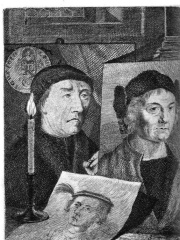
10. Hugo van der Goes (1440 - 1482)
With an HPI of 72.83, Hugo van der Goes is the 10th most famous Belgian Painter. His biography has been translated into 40 different languages.
Hugo van der Goes (c. 1430/1440 – 1482) was a Flemish painter who was one of the most significant and original Early Netherlandish painters of the late 15th century. Van der Goes was an important painter of altarpieces as well as portraits. He introduced important innovations in painting through his monumental style, use of a specific colour range and individualistic manner of portraiture. From 1483 onwards, the presence of his masterpiece, the Portinari Triptych, in Florence played a role in the development of realism and the use of colour in Italian Renaissance art.
People
Pantheon has 109 people classified as Belgian painters born between 1355 and 1958. Of these 109, 3 (2.75%) of them are still alive today. The most famous living Belgian painters include Pierre Alechinsky, Jan Theuninck, and Jan Fabre. The most famous deceased Belgian painters include Jan van Eyck, Anthony van Dyck, and René Magritte.
Living Belgian Painters
Go to all RankingsPierre Alechinsky
1927 - Present
HPI: 64.98
Jan Theuninck
1954 - Present
HPI: 58.80
Jan Fabre
1958 - Present
HPI: 57.46
Deceased Belgian Painters
Go to all RankingsJan van Eyck
1395 - 1441
HPI: 82.52
Anthony van Dyck
1599 - 1641
HPI: 80.23
René Magritte
1898 - 1967
HPI: 80.07
Frans Hals
1582 - 1666
HPI: 78.63
Rogier van der Weyden
1390 - 1464
HPI: 78.33
Pieter Brueghel the Younger
1564 - 1636
HPI: 75.41
Jan Brueghel the Elder
1568 - 1625
HPI: 74.63
Jacob Jordaens
1593 - 1678
HPI: 73.06
James Ensor
1860 - 1949
HPI: 72.94
Hugo van der Goes
1440 - 1482
HPI: 72.83
Quentin Matsys
1466 - 1530
HPI: 72.35
Hubert van Eyck
1366 - 1426
HPI: 70.27
Overlapping Lives
Which Painters were alive at the same time? This visualization shows the lifespans of the 22 most globally memorable Painters since 1700.

